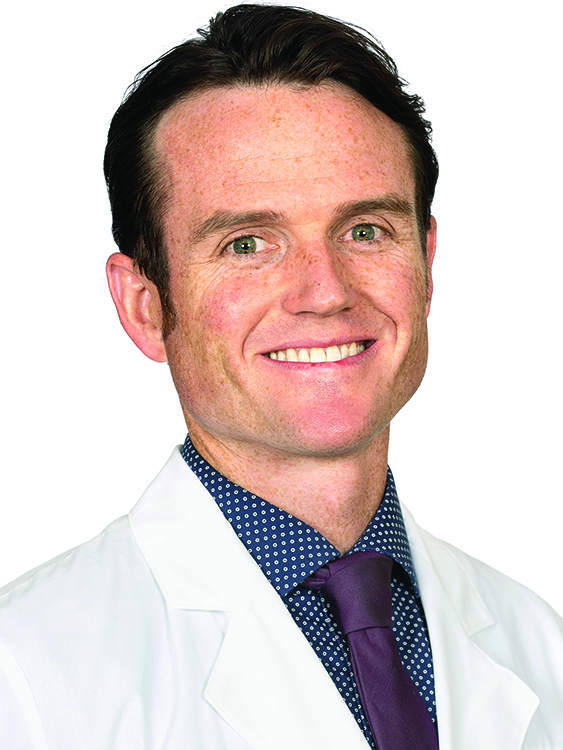Michael Shore knew something was wrong.
The Kernersville retiree, 70, was always active. He began taking art classes a few years back and enjoys working in several mediums, including pencil, watercolor and woodcarving. “Dad is always out and about,” said his only child, Angel Shore, 42, of High Point. “He carries a tacklebox of art supplies with him.”
Shore also loves to hike and often goes to Pilot Mountain, since it’s close to home. He’s also hiked a portion of the Appalachian Trail as well as trails near Albuquerque, New Mexico.

“I realized I was exercising harder and not getting anywhere,” he said. “Walking became harder. Breathing became harder, and my legs were burning. The taste of food wasn’t the same.”
Shore went to his primary care doctor, who referred him to a specialist. Dr. James Dugan, a hematologist with Novant Health Cancer Institute - Forsyth, discovered Shore had acute myeloid leukemia (AML).
Find the cancer care you deserve.
He would need chemotherapy, which many leukemia patients expect. But he’d also need radiation therapy and a stem cell transplant – a much bigger hurdle. Dugan told him he wouldn’t survive long without one. Specifically, he needed an allogeneic stem cell transplant, which is often used in people with blood cancers. “Allogeneic” means the stem cells come from someone other than the patient.
Angel said: “I told Dad, ‘The only person who can make that decision is you.’”
Finding a match
Angel also had a decision to make. Once a blood test determined that she was a match, she had to determine if she was willing. She was already invested in her dad’s recovery. She’d been accompanying him to all his medical appointments – and would continue to for the duration.
But Angel was already dealing with another family health crisis. And she has a 13-year-old daughter. Still, she didn’t hesitate.
“There was no question in her mind once she found out she was a compatible donor,” Shore said. “Our bond continues to grow; it becomes stronger and stronger. There is nothing I wouldn't do for her.”
And Angel proved: There’s nothing she wouldn’t do for her dad, either.
Last December, she donated her stem cells via an outpatient procedure called peripheral blood stem cell collection. Her blood was drawn through a needle in one arm and passed through a device that separates the stem cells from the blood and then returned through a needle in the other arm.
A big first
The toughest part of Shore’s treatment wasn’t the stem cell transplant or even the month he spent in the hospital for chemo. It was the conditioning regimen of chemotherapy and total body radiation he needed prior to the transplant. Common side effects are nausea, vomiting, diarrhea fatigue and immunosuppression.
Last Feb. 10 – after several delays related to Shore’s health – he became the first patient at Novant Health Forsyth Medical Center to have full-body radiation via a more targeted method than has traditionally been used.
It’s called VMAT TBI. In everyday language, it’s radiation for the whole body, but done smarter. It's used to treat leukemia, especially before a bone marrow or stem cell transplant. (See sidebar.) The acronyms stand for volumetric arc modulated therapy – which is the delivery technique – and total body irradiation.
VMAT has been shown to lead to better patient outcomes. A clinical trial at Stanford showed an increase in overall survival rates – and a decrease in toxicities – when compared to the traditional TBI method.
TBI and chemotherapy were necessary to wipe out the cancer cells and make Shore’s body a “clean slate” before accepting his new cells, said Dr. Philmo Oh, the radiation oncologist at Piedmont Radiation Oncology in Winston-Salem in charge of Shore’s VMAT treatment. “And it reduces the probability of the body rejecting the stem cell transplant,” he added.
TBI is different from the course of radiation given to a patient with something other than a blood cancer. “A typical cancer patient getting radiation treatment receives treatment to just the location where the tumor is,” Oh said. “But in preparation for (stem cell) transplant, patients will need their entire body to receive radiation.”
VMAT isn’t new. It’s been used for more than a decade in treating a variety of cancers, because the radiation “tightly hugs the target and avoids nearby tissue we're trying to spare,” Oh said.
But it is new to Novant Health and is still rare through North Carolina and most other states. The reason, said Sarah Wisnoskie, the Novant Health medical physicist and in-house expert on VMAT, is “The mentality by many in the field is, ‘If it ain’t broke, don’t fix it’ – especially when the new method is significantly more complicated and takes much more staff effort.”
Her argument for it is that the reduced toxicities and higher survival are “worth it regardless of the additional effort.”
Post-transplant goals
In giving her dad the gift of life, Shore said Angel “lived up to her name, for sure. She’s sharing her stem cells – and brain cells – trying to keep all my treatment details straight.”
His daughter isn’t the only “angel” in his life, Shore said. “The nurses on the ninth floor (at Novant Health Forsyth Medical Center) have been awesome.”
He also had high praise for Becky Meinecke, manager of transplant and cell therapy; and Laura Lamb and Caitlin Vitulli, who are both HCT & cellular therapy coordinators.
Angel reports that her dad can see his beloved Pilot Mountain from his window at home. And it’s motivating him.
“His goal is to be able to hike Pilot Mountain by this time next year,” Angel said. “Since he and I share a love of music, I told him that once this is past him, we’ll go to Red Rocks for a concert.” The famed Red Rocks Park and Amphitheatre is an outdoor venue in Colorado.
Shore has to take it easy for the foreseeable future, and he’s following doctor’s orders. But he said, “I want to get back out on the trails. I want to spend time with my daughter and granddaughter … with friends and at church. We all try to do our best, and this right here (referring to his second chance) gives me an opportunity to do better.”
More targeted, less toxic
A newer form of total-body radiation – which is necessary for stem cell transplants – is more accurate and comes with fewer long-term risks.
VMAT, a targeted radiation delivery technique, is an excellent option for patients who receive the treatment Michael Shore got – total body irradiation (TBI). And that was fine with Shore since VMAT (volumetric arc modulated therapy) has been shown to improve survival and reduce toxicities.
Dr. Philmo Oh, the radiation oncologist at Piedmont Radiation Oncology in Winston-Salem who treated Shore, described VMAT as being akin to a 3D image, while the traditional way of doing total body irradiation is more like a one-dimensional stick-figure drawing.

That’s important since, as Sarah Wisnoskie, a Novant Health medical physicist, explained, “With VMAT, we can see where the patient’s organs are and spare them.”
Wisnoskie is one of six medical physicists at the Novant Health Cancer Institute in Winston-Salem and an adjunct assistant professor at the UNC School of Medicine. She’s the resident VMAT expert in Winston-Salem, and she trained her teammates on the delivery system.









